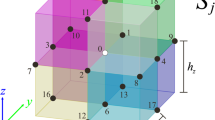Abstract
The finite-element method in combination with the Biot-Savart law is described to compute the magnetic field distribution generated by a dipolar source within a homogeneous volume conductor of an arbitrary shape. In order to calculate the three independent components of the magnetic field outside the volume conductor by means of the Biot-Savart law, the distribution of the current throughout the medium is required. A finite-element mesh is constructed using four-node tetrahedral elements. The potential in each node is computed numerically by the finite-element method using the proper continuity conditions across the boundaries. The gradient of the potential denotes the current density within an element. The components of the magnetic induction are calculated by numerical integration, applying the current density within the tetrahedrons. Simulations are carried out to assess the numerical accuracy for a homogeneous spherical volume conductor. Errors of 3% can be obtained with a locally refined spherical mesh containing about 1000 nodes, for dipoles at any depth and any orientation. A homogeneous realistically shaped model with the shape of the inside of the skull is obtained from magnetic resonance images.
Similar content being viewed by others
References
Bertrand, O., Thevenet, M., andPerrin, F. (1991): ‘3D finite element method in brain electrical activity studies’in Nenonen, J., Rajala, H. M., andKatila, T. (Eds.): ‘Biomagnetic localization and 3D modelling’. Report TKK-F-A689, Helsinki University of Technology, pp. 154–171
Bertrand, O., Thevenet, M., Perrin, F., andPernier, J. (1992): ‘Effects of skull holes on the scalp potential distribution evaluated with a finite element model’. Satellite Symp. on Neuroscience and Technology, 14th Ann. Int. Conf. of the IEEE Engineering in Medicine and Biology Society, Lyon, France, pp. 42–45
Hämäläinen, M. S., andSarvas, J. (1987): ‘Feasibility of the homogenous head model in the interpretation of neuromagnetic data’,Phys. Med. Biol.,32, pp. 91–97
Law, S. K. (1993): ‘Thickness and resistivity variations over the upper surface of the human skull’,Brain Topograph.,6, pp. 99–109
Meijs, J. W. H., Bosch, F. G. C., Peters, M. J., andLopes da Silva, F. H. (1987): ‘On the magnetic field distribution generated by a dipolar current source situated in a realistically shaped compartment model of the head’,Electroenceph. Clin. Neurophysiol.,66, pp. 286–298
Plonsey, R. (1969): ‘Bioelectric phenomena’ (McGraw-Hill, New York)
Wieringa, H. J., andPeters, M. J. (1993): ‘Processing MRI data for electromagnetic source imaging’,Med. Biol. Eng. Comput.,31, pp. 600–606
Yan, Y., Nunez, P. L., andHart, R. T. (1991): ‘Finite-element model of the human head: scalp potentials due to dipole sources’,Med. Biol. Eng. Comput.,29, pp. 475–481
Zienkiewicz, O. C. (1977): ‘The finite element method in engineering science’ (McGraw-Hill, London)
Zou, H. (1993): ‘Anisotropic volume conduction in biological media’. PhD Thesis, Catholic University of Nijmegen, The Netherlands
Author information
Authors and Affiliations
Rights and permissions
About this article
Cite this article
van den Broeh, S.P., Zhou, H. & Peters, M.J. Computation of neuromagnetic fields using finite-element method and Biot-Savart law. Med. Biol. Eng. Comput. 34, 21–26 (1996). https://doi.org/10.1007/BF02637018
Received:
Accepted:
Issue Date:
DOI: https://doi.org/10.1007/BF02637018




